Rishad Tobaccowala's Blog, page 9
June 2, 2024
My Incredible Film Career: Learnings.
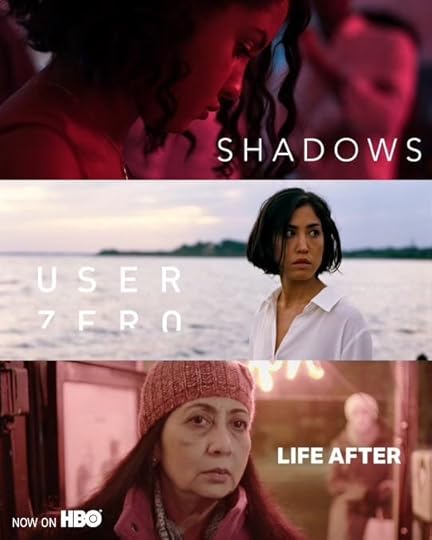
There are some who believe I am a writer, a speaker, a podcast host, a teacher or an advisor.
There are others who may recall some expertise in strategy, media, advertising, communication or transformation.
But all that is a sideshow to my incredible film career.
Now the truth can be revealed about my acting, my producing, my “best-boying” and my “key-gripping”.
All three of my films were bought by and began streaming on HBO June 1 and here are the trailers for your viewing pleasure (for some strange reason I am not mentioned or spotlighted in these trailers…maybe they want to save the best for the subscribers!)
Life After:
Shadows:
User Zero:
Not a Nepo-Daddy!There is a rumor drifting around that this amazing career of mine was made possible because I am a Nepo-Daddy who was given his break because the writer, director and editor of these three films is our elder daughter.
Rubbish!
If that was true, would I have been promoted from best-boy to key grip? Did it not require fortitude and talent to balance heavy equipment between two seats in the front of a U-Haul careening at 3 am through the streets of Brooklyn? Who could in rapid order deploy Uber to feed a cast of many at strange times? And my scene scooping some rice into a plate may have lasted only two seconds but they are the ones that Robert De Niro and others watch again and again for the deep subtlety and nuance of acting that transformed this movie.
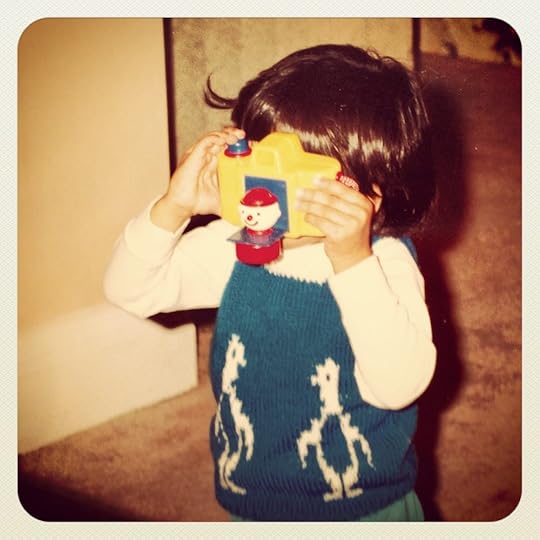
Yes it is true that Ria always loved cameras as the photo above indicates.
And okay she may have some talent but it takes a special talent to see the Bollywood and Hollywood potential of a relative!
In order not to hog all the glory and to prove that I am okay with sharing the spotlight, here is a little bit about Ria from her website: https://www.riatobaccowala.com/bio
Now let me share some learnings that might be useful regardless of what industry one may wish to be a star in.
But first proof (not AI generated) of me being in the middle seat with the heavy equipment between the director and her other producer.

 Learnings from my film career (and observing those of other talented folks like our daughter)
Learnings from my film career (and observing those of other talented folks like our daughter)The creative arts including film in many ways is where transformation brought about by the shifts of multi-polar globalization, demographic shifts and technology are being played out in real time.
It is where the future of work is being defined.
It is the landscape where the upsides and downsides of technology from streaming to AI to mobility are being played out in real time.
Here are a few take-aways
A new ecosystem is enabling talent and are changing the rules of the game: The three movies our daughter made all cost less than $25,000 each and were enabled by the technology changes of the last ten years including: a) peer-to-peer marketplaces which enabled her to rent expensive equipment by the day, b) Airbnb that allowed for low cost location scouting and renting, c) low cost transport via Uber, d) fundraising through crowdfunding platforms, e) mobile video audition platforms to help cast key roles, and f) social media to support promotion. These are just a few of the factors among many more.
A plethora of new ways to create, imagine and monetize are being turbocharged: Now even though it is a dual edged sword AI is providing amazing tools at low cost to millions of creators who did not have access to such tools. Simultaneously, Blockchain is empowering monetization in new ways and AR/VR as well as Epic’s Unreal Engine are enabling completely new forms of storytelling.
A big benefit of streaming is globalization and the launch of new voices: Every week many of the top shows in the US on Netflix are not made in the US but in Korea (Squid Games), France (Lupin) and many other places. If there was no streaming, our daughter's films would not be on HBO, which is no longer limited to a 24-hour linear calendar. YouTube is a global phenomenon and if you want to see amazing Noir programming try MHZ. The gatekeeper and the tastemakers are less and less important.
The media industry is in deep turmoil and maybe where the future of work and intensity of technological change is being most illuminated: The Writers Guild fought hard to ensure that AI did not replace them. As we have seen with the Scarlett Johansson and the Open AI brouhaha or the thousands of fake AI generated books on Amazon this is a very challenging time for anyone in the creative arts. As AI and other technologies advance, some of the ways the entertainment industry has worked for years may change the future for all of us. Specifically every talent is a company of one moving from gig to gig some of which last for hours and others for months (movies) or years (successful tv shows or broadway plays) combining different assignments to create a living. While there are many more ways for talent to be found and to promote themselves, it is also true that there is much more competition and building a brand, a network of relationships, a body of work, and a reputation for being easy to work with becomes important.
Persistence, Community, Luck and a Thick Skin are key: Our daughter has been on a 8 year journey which included being an assistant bringing in coffee and setting up calls (despite 3 education degrees and years of accomplishment at a well known tech firm), unemployment (writers' strike and in-between gigs), being lifted by community (other creatives, the unions, former bosses, and people pitching in for each other), luck (it matters in every career and so much of all of our careers are the chances we get), and a thick skin (rejection is central to the creative process).
Lots more learning but those are the keys.
One more thing I will no longer be at Cannes for Advertising since I now expect to be on the red carpet at the real Cannes…
When not being a major movie magnate Rishad does a few side gigs and hustles noted here: https://rishadtobaccowala.com/bio
May 26, 2024
Maximizing Optionality.

In career and in life, a key is to maximize optionality.
It is important to ensure that except for a life partner, one is not so dependent on a single platform, company, supplier or approach that we loses agency over our future choices.
Optionality also matters across a range of areas in order to remain competitive.
Strategy and OptionalityIf strategy is “future competitive advantage” and the future is hard to see, we need to ensure we have the flexibility to adapt to circumstances and new data.
A case can be made that many leaders and firms including many in the “legacy” media business found themselves either too reliant on a single platform (e.g. Google or Meta or Apple) or too addicted to the margins from the existing business model they did not invest in a plan B to re-think their business model until it was too late.
Very often they limited their competitive set to their existing category and thus limited their options in seeing future threats or future opportunities.
If one does not have choice one cannot make strategic moves.
Timing and Optionality.
While being too early in implementing a strategy is sometimes the same as being wrong, being late is almost always wrong because business models first erode slowly but then suddenly and within months an existing model is no longer profitable or new competition has been allowed to establish strong footholds.
Minimize time on task forces.
Maximize time on tasks.
Tasks that allow for development of minimum viable products, proof of concepts and ways to get teams and organizations moving in the direction of tomorrow. Ways to stress and test the system and allow time for the analog reality of culture and slowness of people to adapt.
Err in the direction of speed to maximize options.
These days it is not speed that kills but the lack of speed that kills.
Career and Optionality.A case can be made that talent who have options are more likely to be loyal.
While this sounds counter intuitive it is not.
The best leaders and best companies build and grow talent so that a) they are constantly becoming more valuable in the marketplace, b) better known in the marketplace and c) have many firms trying to recruit them.
This increases both the success of the firm and the loyalty of the employee for three reasons
a) If one is not growing one’s talent to be the best in the industry how will a company be best in the industry? And if talent is growing to be at the top of their game they are less likely to leave.
b) If one’s talent is well known in the marketplace, they attract both Clients and the next generation of talent who realize that the firm is allowing them to grow their brand and their worth as they grow the firm’s reputation and growth.
c) Being well regarded and constantly building skills allows talent to handle the setbacks that come with one’s career without having to quit since they know they are held in esteem and therefore have options. If one’s market value continues to increase in the firm, one is working at why go anywhere else?
Companies do not transform and grow. People do.
Thus, firms that help people grow and transform themselves and let them celebrate and promote these achievements end up with the greatest optionality in recruiting and retaining people to adapt to transformative times.
The best wants to work with best. Winners with winners. Company growth and personal career and brand growth are intertwined.
Modern Talent Mindset and Optionality.In the US, 66 percent of Gen-Z who have a full-time job have a side gig or side hustle with which they make money. This is due to some combination of needing extra income to make ends meet and building expertise to ensure they have future options and to ensure optionality of income and therefore choice.
76 percent want to work for themselves if they can because after the shocks of the Great Recession, Covid, Tech job meltdown, threat of AI they no longer want to outsource their future to a firm.
So as companies try to figure out how to leverage AI to become more productive either through cost cutting or enhanced products and services, leadership and Boardrooms need to remember that talent is simultaneously thinking about how AI increases their options!
Here are some questions that Management and Talent need to consider regarding their future options in an AI world
a) Who captures the productivity gains? If AI creates productivity gains why will talent not decide to use the AI tools (they are very inexpensive and today more used by talent than companies) so that it benefits them in either working less or asking for more compensation for their increased productivity? What makes companies believe that AI productivity will go to shareholders and the bottom line and not to the talent that uses these tools to become more productive? ( Threatening people with job loss turbo-charges their plotting on optionality! )
b) What is the benefit of seniority? Since AI makes knowledge free (and some folks at Google believes it will make intelligence free) it lessens the advantage of many types of seniority for a couple of reasons. First the rules of the game change and so knowing the old rules are no longer an advantage. Second legacy knowledge is now easily available, and it will not take lawyers or consultants as long to make partner.
c) What is the benefit of scale? Scale matters and has always mattered but increasingly modern tech and AI is providing many benefits of scale to small companies and the individual. We are likely to see many billion-dollar companies with a total of less than a hundred employees
The modern mindset is to re-consider all options including what are the new options to eliminate scale advantages or create new scale advantages.
How best to train and deal with tenure when companies are likely to pay less for knowledge but more for intuition, insight, imagination and ideas.
How to re-think employment and benefits in a modern AI workplace.
Adaptation will be critical and maximizing optionality will be the key to adaptation.
May 19, 2024
Art and Creativity Unleashed.

Art is technology infused with human creativity.
And as technology relentlessly advances the possibilities of art, artists and those that interact and participate with art are greater than ever.
It is no longer a fission of left brain (science) versus right brain (art) but their fusion that will be the future.
From the earliest discoveries of fire to modern computing devices and cloud-based software, humans have bent and leveraged technology in creative ways to express themselves and connect with each other and the wider world.
Fire did not just keep us warm, enabled the cooking of food and forging of new tools but it also let people turn clay into hardened ceramic pots and vases, useful for carrying and storing food, water, or other items which were then shaped and decorated in ways beyond their functional use.
Today like never before technology is enabling artistic and creative endeavors by a) fueling new art forms, b) enabling far more people with a variety of tools to express themselves creatively and c) scaling the ability to share, display and connect with potential audiences and patrons.
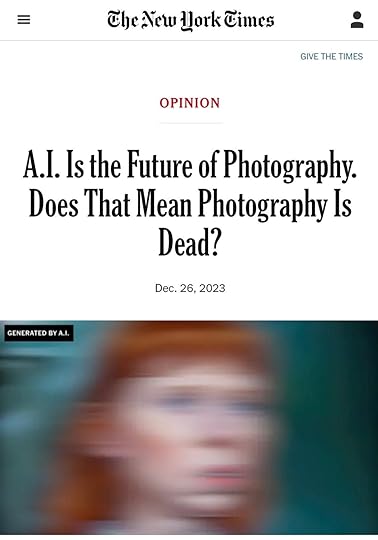 1. Photography
1. PhotographyToday photographs are the most widely created and distributed art form.
They have been turbocharged by camera phones bursting with mega pixels and magical software. The ensuing images are then scaled and distributed via social media feeds algorithmically optimized to maximize engagement.
And modern AI technology now allows for photos to be imagined without being taken and for photos taken to be reimagined in ways that never existed when the photograph was taken.
A long way from Ansel Adams and the stationary bulky camera but also a significant distance from a portable film Leica used by the great photojournalists and creative photographers in the latter half of the 20th Century.
Some folks pine for the days of old.
They need not pine since they can use a medium or very large format camera loaded with black and white film and wait for the ideal moment. But their efforts will pale in comparison to someone using a modern digital Leica Q3 or M11 or even an iPhone15 Pro Max and then tuning the result in Adobe Lightroom with Firefly enabled.
The aforementioned Ansel Adams himself spent hours optimizing photographs in the dark room and were he alive today would probably be an expert at leveraging AI.
While technology enables the possibility and potential of artists it does not necessarily make an artist. Similarly, the refusal to leverage modern possibilities and hold to traditional ways does not cause one to be a more “genuine artist”.
2. FilmIt is in film industry that we often encounter the battle between “the way it was and should be” be versus the future.
Not only is the movie theater increasingly a container of the past but the two-to-three- hour film itself is just one way of modern film expression.
A case can be made that in today’s streaming eco-system artists working in film have far greater ways of expressing and creating their art then when they were limited to movie and television studios of the past. Why be constrained to three hours when the better idea maybe a series (Queens Gambit was originally a movie idea)? Why be limited to what can fit in the few theaters or is curated by some mysterious coven of coastal “taste makers” when a world of possibilities can be sampled and global audiences reached via a Netflix, Acorn, Mubi, Criterion, MzH and much more?
Look at the list of popular films on Netflix and so many come from Asia and Latin America.
The ability to determine how to release (weekly, all at one time, in phases) one’s work, the global scale of audiences reached, the creative freedom and new economic possibilities have made streaming television the new high art form of film versus the movies.
Most theatrical movies are now commercials for the eco-system of spinoffs and merchandise that follows. And many of the truly artistic films which may be more edgy, risky and artistic movies from Roma to The Irishman to One Night in Miami are now funded and launched by the streaming channels. They are not crushing but unleashing creativity like never before on a global scale.
A reason “The Mandalorian” on Disney+ has resonated so well is the fact that it has the space to build its world and story versus being Star Wars 10: The Emergence of Yoda. And with modern Unreal Engine 5 technology and its cylinders we can get visual effects far more real than green screen.
With larger and cheaper OLED screens, audio spatial software bringing surround sound to headphones and improvements in discovery, every technology advance in film is taking place in personal and home viewing spaces.
If you have not spent time with Apple Vision Pro (now rolling out globally) you must get a 30 minute free demo and ask to see the Alicia Keyes rehearsal and see some spatial photography. Apple has unleashed the future of film and video and a far finer theater than one that exists in the real world. Watching Avatar in 3D on a Vision Pro is an incredible experience. Spatial computing and everything else that Tim Cook promised will come but the future of content consumption is here (but currently very expensive and very individualized).
 3. Music
3. MusicWhile there is a recent resurgence in vinyl among the diehard aficionados the future of music is streaming and increasingly integrated with video whether it be on TikTok or YouTube or the streaming platforms.
Most of joy of vinyl is in the ritual rather than the result. There is a certain joy in placing vinyl on a turntable, perusing the liner notes and accompanying art that the physical format enables. Then there is the romanticizing of the crackling hiss of mechanical impurity brought to life by the scratches that is all about a memory and a story. A memory and story separate from the “warmth” of the music that only vinyl can supposedly re-create.
The great American audio gear firm, McIntosh, with its old-fashioned transistor quality has seen the future and has been releasing their wonderful gear with its glowing green dials optimized for headphones connected to digital music.
Streaming music via Tidal (much higher quality than Spotify), with a great pair of headphones and digital amp is absolutely stunning as is Spatial Audio on Apple.
The benefits of streaming not only include the convenience, catalog depth and curation (both software enabled and curated by other subscribers) but increasingly the curation and community provided by artists and emerging artists.
Bandcamp and Soundcloud are two excellent sources for a different independent and less commercial take on music than those of Spotify and Apple Music.
The other area of great advance in music is in automobiles. Today it is very likely that the best sound system most people have is in their cars. The major audio companies now combine hardware and software design working in tandem with the auto manufacturers as the cars are being designed (McIntosh has partnered with Jeep). The new Mercedes S Class has speakers in seats that vibrate to music at certain software settings to create a 4 D sound experience!
To understand the power of how modern technology can unleash and enable music check out Digital Concert Hall of the Berlin Philharmonic which among other things has one of the best user interfaces and discovery engines I have interacted with. Any company waxing poetic about “Brand Experiences” should check them out (unfortunately most of the functionality requires a subscription which I would highly recommend even if for just a month to truly understand what is possible)
What makes the Digital Concert Hall amazing is that when the new physical orchestra hall was constructed in Berlin it was built not just to optimize sound for the live audience but to record high quality audio and video from multiple angles for home subscribers and streaming audiences. As a result, you feel you are sitting in the orchestra and watching and hearing the music in ways that enable a new level of appreciation.
They built and anticipated for a global and digital and a new demographic future where the next generation of concert subscribers might wish to engage on demand from home and that home maybe in Japan or India and not in Berlin.
Because of their foresight, the Berlin Philharmonic continues to perform all through the challenges of Covid-19 for the world and their subscribers even though they are playing to an empty orchestra hall.
And for the aspiring Mozarts and Dylan’s of the world there are new ways to learn instruments and much more. For instance to understand the depth of what is possible if you wish to learn (or teach) guitar take a look at Truefire Studios.
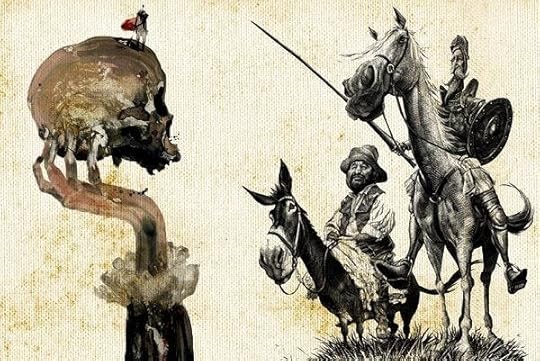 4. The Written Word
4. The Written WordBefore photography, film and recorded music came the word and its most popular containers the broadsheet newspaper and the bound book. Both remain with one (the physical newspaper) in deep decline while the other (physical book) continues to grow and prosper.
A case can be made that two of the greatest works of art every created were conceived nearly 500 years ago in the 17th century. The first and possibly still the greatest novel ever Don Quixote and the greatest play ever William Shakespeare’s Hamlet. Almost everything since is a variation and combination of these two classics.
The broadsheet after being continuously diminished in its size and heft has been increasingly replaced by its digital manifestation while the book has been complemented rather than be replaced by its audible and electronic representations.
Why has the vinyl of reading, the humble book, continued to grow? Is it because the form allows for disconnection so one can immerse in a world of imagination and the focus of deep learning? Or is the ability to underline sentences and scribble in the margins arguing or agreeing with the author something difficult to replicate in a digital format? Or is it that when you are reading a book in many cases you are both everywhere and nowhere and the silence of print is particularly enabling to this reverie? Or it just might be books make great artifacts to decorate a room or office or signal learnedness and taste?
While the book prospers the written word has also burst out its containers of the past with new formats including blogging platforms like Wordpress and Medium or newsletter publishing from Substack, Beehiv, Ghost and others.
Here are some statistics about Substack:
As of March 2024, Substack has more than 20 million monthly active subscribers, including 2 million paid subscribers.It received 122.59 million visits, with an average session duration of 9:07 and the top 10 authors on Substack in combination make $25 million per year.
These new forms of writing, reaching and monetizing an audience are some of the on ramps for emerging talent and off ramps for established talent to and from the world of newspapers, magazines and books.
 5. Museums
5. MuseumsThe world’s greatest Museums are no longer in Paris, New York, Chicago, London or Florence. They are in the Cloud and probably best portal into the amazing world is Google Art and Culture Page (Openculture.org is another great portal)
Here, the full power of modern technology to support, promote and celebrate art and culture is in full display. Walk through museums, get microscopic looks in high definition to a small part of a painting, rotate and move sculptures and much more.
Travel across the world doing deep dives into the landscapes outside museums, the interiors of the museum and all the art that lives there.
Yes, they do not replace a visit to a museum.
They may have surpassed the museum!
And for most of the world it will be the only way they get to a museum.
On Apple Vision Pro there are some great art apps and one can just imagine the child of a marriage between Vision Pro and Google Art will birth regarding the museum experience.
6. Mongrel MediaDigital is like hydrochloric acid.
It burns through constraining containers.
This is true in business and art.
Today the state of the art of what technology can do to unleash creativity is Unreal Engine 5 ( see the demos above) which drives the latest games, immersive experiences and enables some of miracle of cinema.
But all media is melting and morphing into a melee of multi-media and multi-channel munificence.
Podcasts:Take the intimacy of the written word and marry it with digital sound and the access of cloud-based delivery and you have a wonderful recent form called the podcast. Now quite a few have a video feed.
TikTok: Take modern AI, the ubiquity of the mobile phone and combine it with the creativity of people and you have a fast growing, highly addictive, new content form called TikTok.
New York Times Digital: Take world class journalists and photographers and combine them with digital artists, software experts and remove the constraint of space or being limited to the printed word or even the news ( Wordle anyone?) and you have New York Times Digital.
Gaming: Take hardware, software, film, music and story telling and fuse them and you get the nearly 500 billion dollar global gaming industry which is larger than the film, music and publishing businesses combined. Starting on low powered consoles it has spread to hand held consoles, cloud based delivery, mobile phones, consoles with the power of super computers and much more.
If you want to see the most amazing future of advertising, content and AI check out what Microsoft is planning and unleashing in the gaming world. Gaming is where all the top technologies from Unreal Engine to AI to Metaverse to Blockchain are being optimized. Brands who are not paying deep attention to the gaming ecosystem should.
And it will not just be Microsoft but many other firms including Meta which has a lot up its sleeve and the potential of gaming is why Disney spent 1.5 billion dollars to purchase a small stake in Epic the owner of Unreal Engine.
The future does not fit in the containers of the past.
The pipes to the future are laid by modern hardware and software plumbing.
But it is the human connections and art and meaning that this plumbing enables that makes life worth living.
Let us not fixate so much on the plumbing that we forget the poetry.
Let us not call for the good old days when the best time for creativity is now.
We are the most wonderful age for creativity and artists and the commercial that Apple released for the new iPad should be viewed in reverse. Technology unleashing the Arts rather than Technology crushing the Arts. See the better version here:
May 12, 2024
Exercising Belief.

Photography by Sho Hoshino
In today’s changing world amidst chaos and conflict there is a break down in trust, an increase in polarization and a rise in rage.
We all have a list of bad actors, things that we oppose, ideas that we reject and views that we abhor.
It may be worth the while to also make a list of what we believe to be true.
Ideas or insights gleaned from experience, or from our elders and inspirational people or from our own experience that provide the wisdom to steer our lives by.
A focus on what we running towards and what keeps us running, rather than what we are running from or believe are running things down.
Here are a list of five beliefs to drive a life operating system:

Photography by Sho Hoshino
1. Life is how one deals with loss, connects with love and grows through learning.Loss: Loss is central to the human experience in three ways:
First, is we often lose in our attempts to succeed. We lose promotions, jobs and opportunities. We lose money and valuable assets.
Many times, we also win.
Some people win a little and others win a lot.
But we all lose.
But these losses however daunting and disappointing are not the big ones.
The second set of losses are the losses we will face of loved ones and friends either because relationships end, or death comes.
And our final loss is that of ourselves.
Our health.
And then our lives.
Franz Kafka wrote that “the meaning of life is that it ends”
How we live amidst these losses defines a large part of life.
To learn to practice “personal resurrections” after setbacks and to endure and keep on growing and going.
Love: A big part of what makes life worth living despite the guarantee of loss is love.
Love of people, of work, of art, of culture, of craft and of things and hobbies.
It is in fact this love and attachment that is deeply intertwined with the feelings of loss
Love does not compute; and computers though they are getting increasingly advanced into deluding us that they love us since they ingest all our stories and then customize their reaction to be our “personalized” friends cannot love us.
In part that is because they cannot feel.
And therefore cannot feel loss.
And with love comes loss and love is an anti-dote to loss.
Learning: Today we have large language models that learn by ingesting, sorting, parsing, co-relating, re-combining and digesting all they can eat.
It is clearly a form of learning and the machines are getting “smarter”
Thus while machines may not know about love and loss they definitely can learn.
But do they feel joy as they learn?
Without the reality of loss or the feeling of love can they turn information into insight into wisdom?
Love, loss and learning are intertwined with each one feeding and influencing and resonating with each other.

Photography by Sho Hoshino
2. Success is being able to spend your time in the way that creates joy.Success is sought by all but what is being sought?
For some it is making a mark in their field or leaving some enduring work. For others it is seeking financial wealth or creating and nurturing a family. For some it is helping others.
For most people success also means a measure of happiness.
In the end if time is all that one has than success probably has to do with how one uses time.
Ann Dillard wrote that “the way we spend our days is the way we spend our lives”
When one is financially constrained one’s mind and time are colonized by making ends meet.
When one is physically in pain or suffering from ill health it is often hard to be happy.
So, if happiness is the ability to not spend time thinking all the time about ones financial or physical situation it means a certain amount of financial and physical well-being is key to being happy and possibly successful.
Sooner or later once these basics of not having to worry about the next rent check or waking up the next day are overcome the words and emotions that link the happy and successful are those of purpose, meaning, connection, flow, recognition and growth.
And these can change over time and are different for different people.
But it all comes down to having the freedom to allocate one’s time the way one does.
How can we spend your time, that increasingly gets to a place where we spend more of it in ways that give us joy?

Photography by Sho Hoshino
3. Do not live in other people’s minds.It has been written that “comparison is the thief of joy” but so is living one’s life to score points in somebody’s else’s scoreboard of what success is.
The rise in mental anguish among teenagers is in part how social media has accentuated the need to look good in somebody else’s eyes.
But it is not just teenagers who live in other people’s minds versus theirs.
Caring what other people think is human and often learning and getting feedback on how one can improve is key to success so not living in other people’s minds does not mean not listening to or caring what other people say or think.
It means stopping using their metrics and their rulers of success to rule the way we live our life.
If nobody was looking and we do not have to preen and strut would we live differently?
Living in other peoples minds is like giving somebody else a remote control to direct your life.

Photography by Sho Hoshino
4. There is nothing good or bad but thinking makes it so.While one may not agree with Hamlets’ statement that “there is nothing good or bad but thinking makes it so”, our mindsets matter a lot in how we perceive life, how we are perceived and the degree of success we may have in our varied endeavors.
In rapidly changing and chaotic times an agile mindset can be critical to success.
How we react to a thing or event is often what determines the impact of the thing or the event.
While there are many personal trainers to help sculpt our bodies into somewhat supple forms, there is a scarcity in those who can show us how to exercise our minds to be as flexible as they need to be.
Mindsets matter.
Growth mindsets. Learning mindsets. Optimistic mindsets. Realistic mindsets.
Optimism matters.
In the novel “Gravity’s Rainbow” by Thomas Pynchon a character is described as one whose “mood collapsed the room”.
While misery may love company, nobody likes being in the company of miserable people. Optimism is not just an essential component of innovators but a trait that you must have if you wish to inspire folks to follow you. “Woe is me, doomed are us” works for a few drinks in a bar, but at the workplace it saps energy, hurts culture and is just a plain downer. Pessimism is something we all wallow in, but it fails to show the way out.
A way to get optimistic is to forget all the legacy nonsense we may have to grapple with and ask that if we had a fresh sheet of paper and no constraints except those of the law, science and the need to become/remain economically viable what would we do?
Can we reframe, rethink and reinvent?
Every day is a new career beginning.
Tomorrow is where we will spend the rest of our lives.

Photography by Sho Hoshino
5. Practice Compound Improvement.The single most powerful concept in finance is that of compounding.
Compounding interest and compounding returns can over time create wealth or lead one to bankruptcy depending on whether you owe or own capital.
In a world of change we all may want to consider another way compounding can help us grow in changing times and drive mental, emotional, and even financial wealth which is compounding improvement.
There is so much we cannot control in a world driven by global, demographic, social and technological change but instead of being buffeted about helplessly in a sea of chaos maybe we can try to control and build our ourselves to be better.
Three learnings about compound improvement.
a) Discipline equals Freedom: This is the title of a book by Jocko Willink, a Navy Seal. Basically, if we want to get a grip on the world get a grip on ourselves. Things are more up to us than we think if we are willing to work at it.
b) Never graduate from school: The world is changing so fast that many of our skills and expertise and mindsets need continuous upgrading. While many of us set aside time to exercise to maintain our physical operating system we need to also feed and exercise our minds. The power of this habit is that at the end of a year one will have spent 365 hours learning new things by just doing one hour a day. The day we start dying is the day we stop learning.
c) Deliberate Practice: Anders Ericcson wrote a book called “Peak” which is the best study of deliberate practice. Deliberate practice involves three components
1) immediate feedback, 2) clear goals and 3) a focus on technique. According to his research, the lack of deliberate practice explained why so many people reach only basic proficiency at something, whether it be a sport, pastime, or profession, without ever attaining elite status.
To become great become great at something. It may be art, business, fishing, caring for somebody. All of us have some great expertise and things we can give the world.
We just need to architect, hone and sculpt with deliberate practice to unleash our skill on the world just as Michelangelo revealed “David” by removing all the marble that was not him.
Try an exercise of listing a few beliefs that drive your life or ask others to do so.
It is likely to help one grow and connect better with others.
May 5, 2024
Small Things.

Visual Art by Susan Swinand
Every six months for over three decades I receive an updated insurance card from State Farm.
Over the years the quality of the card has deteriorated in every single way.
The card used to be plastic and then became a thick removable card and then it was something that had perforations on a larger size of paper that you had to tear and now it is as thin as it can get with scissor marks where you need to cut it.
The quality of the card plunges in inverse proportion to the increase in premiums (no accident or any reason to justify the increases in premium).
It is a small thing.
But it is the only time the brand and I interact (assuming that I remain lucky enough not to have to file a claim). Its their twice annual contact point. And every time I open their mail I see a cheaper card some confabulation of consultants, accountants and financial operators have optimized to reduce costs along with a standard completely non customized come on to buy more insurance along with the gift of a higher premium.
Maybe the masters of optimization may want to consider a little less media spend on Jake from State Farm commercials to help fund a better existing customer interaction in the twice annual touch points?
It is a small thing.
But small things matter.

Visual Art by Susan Swinand
Recently I flew to Singapore. Outbound on Singapore airlines. Return on United.
I have no status on Singapore. Highest status on United.
Same aircraft and with no significant difference in interior.
Same catering service so the food was not really different.
Dramatically different experiences.
United was acceptable. Singapore was outstanding.
It was the small things.
On Singapore the stewards and stewards knew your name and looked at the passengers and smiled. The hot towels were hot. The utensils, napkin and the crockery may have been the same material but one just felt much more special. The contents of the vanity bag, the quality of the eye mask were all an edge above.
On one airline they asked how much cost can we remove and on another they think about how a few more dollars on a multiple thousand dollar ticket can make a difference so lets not be penny wise and pound foolish.
And smiles they are free.
Such small things made the difference.
Because small things matter.

Visual Art by Susan Swinand
Over the years many people have called me or reached out to me when in transition between jobs or when they are out of work or when they need a boost.
Almost every time I have responded and often met with or spoken to or written back to each of these people.
They no longer had power. They no longer had the big brand name. In some cases they were a confused hot mess because they had got laid off, their company had tanked or something dramatic had changed the trajectory of their career.
Many were surprised (especially when I had a big job in a big company ) that I made it a priority to find time to get back.
Almost every one of them in time got back on their feet or found their way and often soared to amazing career and vocational success.
Now once again they were in demand and everyone called back.
But they were different because of what they had experienced.
They no longer equated themselves with their positions and their big company brand names and they now called people back who needed help even if they might not have before.
Because it is when few people are willing to speak to somebody is exactly when we need to speak to them and pay attention.
It is a small thing.
But people remember.
Forever.
Because small things matter.

Visual Art by Susan Swinand
Small things and marketing.For decades marketers have found certain stages in a person’s life where they are more susceptible to messaging and marketing.
Whether it is the impending birth of a child to a physical re-location there are times where people are more open to change or to paying attention.
Marketers also recognize that there are moments of interaction where up-selling or cross-selling is likely to be more successful, such as when someone is opening an account or when one is about to pay for items in one’s real or digital shopping cart.
Basically, marketers look for moments of greatest attention and interest.
The challenge is that everybody knows these rituals and some combination of high costs and fees to show up at these moments or a certain weariness and understanding by people of what is happening, makes these less differentiable.
If instead of thinking only about where someone is on a customer/purchase journey we think about where we can surprise them positively the most, or turn a negative to a positive, we find compelling moments.
For instance, if we want to get people to speak well about our product or service instead of advertising to them or desperately try to get likes or influencer mentions, why not give them a sample of the product for free? Why not re-allocate a portion of the communication budget to enhance the quality of the product or service which will then speak for itself and get its satisfied users to speak about it. In today’s world brands are more likely to scale through people if they have a superior product or service rather than just telling people they have a superior product or service.
Imagine if you were a cable company or publisher and re-allocate the “stop them from unsubscribing” budget where you slash prices, increase channels in a bundle or enhance broadband speeds to people who are quitting, to instead reward the most loyal customers by going to them and cutting their fees and/or upgrading their services to simply say thank you.
When someone least expects an act of generosity it has a tattoo like impact.
It means they are special, and they are not being taken for granted.
It is just a special small thing.
So many marketers promise to “surprise and delight” customers but do we really?
One or two small “surprise and delights” might be worth a year of messaging
Less is more. The rare is meaningful. The special resonates.
Traffic in scarcity to stand out in a world of abundance, sameness, and noise.
Thing about the small things, the moments that you can tattoo so by asking “what can we do and where can we do something that will make someone come away different”?
It may be small things.
But small things matter.
April 28, 2024
8 Perspectives on What Next?

We all wonder “what next?” since we will spend the rest of our lives in the future.
How can we best understand key trends and the opportunities and challenges tomorrow will bring?
What can and should we do to position ourselves, our teams and our businesses in a way that allows us to thrive?
One way is to ask a range of world class individuals who marry expertise, craft, bravery, risk-taking, passion and a track record of pioneering across a wide spectrum of subjects and areas, about what they believe is next in their fields.
Over the past four years I have spoken to over 100 talented people across the world who have made their mark in the arts, business, culture, science, technology and much more asking them for the three biggest things they see coming next that everyone should pay attention to.
These conversations are professionally recorded, distilled, edited and supported by a world class team working across three continents at the Publicis Groupe which then make it available completely free (no subscription fee and no advertising or promotion) on every major podcasting platform across the globe (and to all 106,000+ Publicis Groupe employees via the internal Marcel platform.)
You can find the conversations on Apple here:
You can find the conversations on Spotify here:
8 Perspectives from Season 5.We record 24 shows each year in three seasonal bursts of 8 episodes.
This season of 8 shows reflects the range of guests and subjects which makes this show unique in that it does not focus on a subject, a country, an ideology or a technology.
We do not even have a well-defined “target audience”!
Just humans who want to learn and grow and ensure a better future.
So the conversations focus on helping people see, feel and think differently about how they can grow themselves, their teams and their business.
The goal is to have the listener come away with accelerated insights, actionable inspiration and a feeling that the guest helped them augment intelligence.
AI’s of a different type than the AI we are all preparing for.
Here is a very small sampling of perspectives from each of the 8 people we were privileged to speak with this season ( You can find all these 8 episodes plus the first 2 of the next season and dozens of other conversations on your choice of a podcast platform by typing in “What Next? Publicis Groupe”).
Listen to any one and it will open your mind. Listen to all eight and you will be significantly better off as a person and a professional. Your “what next” will likely be an upgraded version of you before you heard “What Next?”
1. John Kosner on the Future of SportsJohn Kosner is the President of Kosner Media, a digital media and sports consultancy and an investment advisor to sports tech startups on the future of sports.
His four decades of expertise include building ESPN into the world's leading digital sports destination; he also struck ESPN's original streaming deal with Bamtech, which led to Disney's acquisition of Major League baseball's technology firm in 2016.
In a world where sports is dominating media and fusing with gaming anybody interested in business should listen to it (even if you are the rare bird who does not follow sports.)
John argues that sports will follow gaming into the interactive world building communities around sports players online and offline as younger fans look for new ways to engage.
He advises us to follow his old Disney colleague, Steve Jobs’ mantra: “beware the status quo” in a world where everything including sports is being re-imagined.
John explains why integrity and trust will be key in a world of sports as AI and sports betting scale.
2. Rudina Seseri on AI Language ModelsLong before AI was cool Rudina Seseri, Co-Founder and Managing Partner of Glasswing Ventures was investing in the space. Amidst the hysteria about AI it is great to hear a deeper, more reasoned and seasoned perspective on AI from someone with 19 years of investing and operational experience in high-growth AI and Frontier Technology companies.
Rudina argues that large language models will become smaller, more distilled, more refined, and therefore more powerful, while the transparency of the open-source and open model landscape will enable companies to control their own destinies.
Rudina also believes that the Coming Wave, predicted by author Mustafa Suleyman, will strip the paint off some AI companies to reveal the true AI-Natives set to thrive.
3. Richard Townsend on The Future of WorkRichard Townsend is CEO Workforce Learning at QA which delivers learning programs to some of the greatest companies in the world shares insights on how Al is going to create better humans.
He shared how the key is to get companies to adapt work and organization to AI versus just adding skills and expertise.
How a growth mindset and learning organization will combine AI, data and the cloud in new ways to augment humans.
Augmented Humans is a profound idea.
And ultimately that is where real productivity starts to happen.
4. Lisa McCarthy on Up-skilling.Lisa McCarthy is the CEO and co-founder of The Fast Forward Group, a training and executive coaching company that gives people a proven approach to think big, manage stress and achieve success and fulfillment in their whole life.
Prior to starting Fast Forward, Lisa spent 25 years at prominent media companies Univision, Viacom and CBS leading sales organizations responsible for billions in revenue.
Lisa shares how to help teams overcome the toll of high-pressure, always-on workplaces where people feel professional success requires personal sacrifice.
Lisa explains that there will continue to be a significant war for talent and leaders are already learning that they will benefit more from up-skilling the people they have versus trying to get external talent that may or not make it in terms of onboarding.
5. Lou Paskalis on the Role of Advertising on News.Lou Paskalis is Chief Strategy Officer of Ad Fontes Media, CEO and founder of AJL Advisory. Lou is a former president and chief operating officer of MMA Global and was a senior marketer at Gallo, American Express and Bank of America.
Lou frames and explains the business opportunity that the return to News represents for marketers which also has the added benefit of bolstering our society. He discusses why the unfounded fears of becoming collateral damage in the culture wars has sidelined many advertisers and deprived news publishers of a valuable source of advertising revenue at a time when they are actively combating disinformation and misinformation in a growing war on truth.
Lou notes that as AI becomes mainstream, the proliferation of misinformation it could create will exacerbate what we are already seeing today. Some bad actors will introduce "deep-fakes" that will be harder for consumers to discern and technology to detect. These ultimately threaten everything from the way business gets done to our society and indeed, democracy itself.
But at the same time, AI will help news publishers hone the appeal of their core product by helping them easily and efficiently tailor their offerings to disparate audiences.
There are big opportunities for savvy marketers to partner with news publishers by investing in news advertising and enabling new technologies to bring both news and their messages forward to grow their business.
6. Mark Grether on Mobility Media.Mark Grether today runs Uber's advertising business in over 30 markets. He also sold Sizmek to Amazon and was the one of the architects of WPP's Xaxis.
Mark explains why we are in the renaissance of marketing and it is not that CMO's are being eliminated but rather they are being elevated as marketing becomes the growth driver in this new age.
Mark predicts there will be many more platforms ( Like Uber, Walmart Connect and much more) as companies realize they are in a B To C business ( products and services to consumers) and a B to B ( data monetization for partners and companies) business.
How mobility media is joining mobile media to create a new palette of opportunities, businesses and experiences for people because knowing where someone is and where they are going is as important as who they are. And why soon the car may be another living room and the auto companies will be huge ad sellers at Cannes selling their connected (tv and other) experiences.
How online and offline, above the line and below the line and much more are fusing and why fusion is the path forward from confusion.
Why businesses have always used machine learning in media to find the right person at the right place and the right time but AI will allow one to craft the right creative.
Joey Hubbard has worked with Tiger Woods, Kobe Bryant and many leaders before becoming the Chief Training Officer at Thrive Global which he co-founded with Arianna Huffington.
Joey believes a key to the future is to be resilient and understand why looking after your and your team's well-being is critical.
One has to be well. To lead well.
Joey shares provocative insights into how to thrive given the pressures of today including
a) why workplaces mandating RTO need to offer something to “earn the commute”.
b) taking care of yourself is the least selfish thing you can do!
c) the power of tiny habits which we can leverage right away.
8. Kirthiga Reddy on Blockchain.Kirthiga Reddy was the first employee of Facebook in India. She is a transformative leader, pioneering engineer, advocate for fairness/opportunity and also a hugely successful leader at Meta/Facebook, first female investment partner of Softbank, co-founder of Liftery and now the CEO and Co-Founder of Generative AI and Blockchain start up Virtualness.
In this conversation, Kirthiga discusses the enabling opportunities provided by Blockchain, Generative AI, and the rise of India.
Kirthiga argues that in the world of Gen AI, blockchain is going to become even more important for creators, brands, sports media, and entertainment.
Kirthiga believes that the read-write-own era that blockchain ushers will give individuals including many who have never had the ability to leverage their talent new ways to monetize their side hustles (and also main hustles) and help bring forth a fairer and more creative world.
She envisions a future where all moments that matter — including awards, certificates, memorabilia -- will be on blockchain.
And if these are not enough you can hear the first two episodes of Season 6 where Sophie Williams a former leader at Netflix speaks about the need for more senior women and John Winsor an executive in residence at Harvard Business School shares thinking about being open and about talent in the cloud.
Or hear episodes about Managing Gen Z from author Heather McGowan or how to best give and receive feedback from executive coach Kim Scott. Or hear about about risk taking, failure, trust and continuous re invention from the legendary Maurice Levy.
Coming soon the future of law, cancer care, and much much more.
All subscription and commercial free and accessible on every major platform in the world.
Click here for access to all the episodes of “What Next?”on Spotify
And here for access to all the episodes of “What Next?” on on Apple
April 21, 2024
The Age of De-Bossification.

Illustrations by Ralph Steadman
In many industries particularly “White-collar” ones the era of “bosses” is in decline.
There is a rise in the need for leaders, guides, coaches, mentors, role-models, creators, and builders.
Less of a clamoring for bosses, managers, controllers, monitors, evaluators, and paper pushers.
This shift has been driven by changing demographics, the spread of technology, the rise of unbundled and distributed work, new behavior expectations, and a re-definition of what “work” is including the rise of fractionalized and free-agent talent who work for themselves or at multiple jobs and are expected to comprise most of the work force in the US by the end of the decade.
How to a “de-bossify “ourselves or help others do so and therefore adapt from being a “boss” to a “leader”?

Illustrations by Ralph Steadman
Step 1: Be Aware of Bossy Traits!All of us have both worked for and in times of pressure we ourselves have displayed one or more of these “bossy” traits:
1. THE NARCISSISTIC GOD. These bosses believe that only they know the answer, only they are capable of handling the major meeting, and only they should get the credit for their teams’ success. They often believe they transcend the company. In many instances, they create a godlike cult that worships their every move, using public relations and social media to spread the word.
2. THE MICROMANAGING FIDDLER. These folks are terrific operators—they know how to get things done—but as managers, they retain their obsessive detail orientation. They tell their people what to do and insist they check in with them at every stage. They are insecure and can’t let go of anything. They often manage via spreadsheets or the need for slavish following of systematic procedures.
3. THE OSCAR ASPIRANT. These types emote, loudly and dramatically. Erratic and unpredictable, they are a roller coaster of emotions. They greet bad news with histrionics and good news with hyperbole.
4. THE SCHEMING SPHINX. This is the person who smiles, blows air-kisses and oozes charisma and friendship, says nor shares anything substantial, while sucking up as much information and probing for vulnerabilities. A blend of insecurity and bully juice wrapped in a blanket of charm while oozing calm and friendliness.
5. THE DOUBLE-CROSSING ASSASSIN. While the previous four types are expressive (or anti-expressive in the case of the Scheming Sphinx) in their terribleness, Assassins are soft-spoken, well-behaved, and self-controlled. Behind closed doors, however, they take credit for other people’s work, create animosity by speaking ill of people to others, and find ways to trip up others and make them fail.

Illustrations by Ralph Steadman
Step 2: Understand why the old model is collapsing.Once upon a time a manager controlled the flow of information, access to opportunities and was a font of expertise and craft.
Today the half-life of knowledge is growing shorter and shorter and the “way of this is the way things were done” is often the opposite of what needs to be done as new competitors and customer expectations do not care a fig about the way it was or is.
AI will turbo-charge this change in ways deeper and faster than anyone of us can even comprehend as the cost of knowledge goes to zero and enables talented individuals to combine, re-combine, scale and re-invent in new ways.
Talent can find information, opportunity, and knowledge at a click of a mouse, a sharply written prompt or the pinch of a finger.
The unbundling and distribution of where and when we work has just begun and culture, teams and excellence will need to be cultivated across time and space with limited in-person interaction as the age of AI, Web 3, XR will make working anywhere and everywhere increasingly the default state in white collar industries making old-fashioned monitoring, controlling, and overseeing difficult.

Illustrations by Ralph Steadman
Step 3: Understand New Leadership.Modern leadership is about zone of influence versus zone of control.
People follow people and not titles.
Leadership is a role and not a job title.
It is a way of being infused with a passion for excellence and a quest for middle to long term multi-stakeholder growth (company, community, employee, leader) versus a focus on the short term and emphasizing only investors/owners.
It is the ability to communicate and motivate in person and across space. To tattoo moments and make the most of every interaction. To inspire, guide, mentor, build, empathize and unleash.
Most importantly it is about the continuous feedback and learning of a growth mindset.

Illustrations by Ralph Steadman
Step 4: Transforming from boss/manager to leader/coach.As times change the best managers adapt and learn and flex into new shapes and learn new skills. Transformation is possible for those who care to try.
Just because someone has bossy traits and was forged in a different era does not mean they cannot re-invent and re-wire their skills if they want to.
This transformation requires three conditions:
First it requires today’s bosses to accept that to grow and remain relevant they will have to change and while it may be difficult it is better than becoming irrelevant.
Second it requires their leaders to ensure that new incentive systems that are more about zone of influence, growth of craft and people versus zone of control of budgets and team size are put into place.
A new way requires new pay.
Third there is an urgent need for coaching and training and patience to help today’s managers become tomorrow’s leaders.
A personal hunger supported by new incentives and buttressed with training including the opportunity to self-learn is the formula.
Talent is short and it is a mistake to believe that seasoned employees cannot grow into new potential.
New brooms sweep clean but old brooms know the corners.
April 14, 2024
The 3 Relevances.

Photography by Felicia Perretti
Change sucks.
But irrelevance is even worse.
Today most firms, institutions and individuals are grappling with 3 levels of relevance.
Does my firm have a relevant business model for the future?
Does my company have the relevant organizational structure, talent mix and suppliers/partners to succeed tomorrow? 3.
Do we as leaders and practitioners have relevant skills and expertise to navigate the transformed world ?

Photography by Felicia Perretti
Relevant business models.A case can be made that every company needs to interrogate its business model given the changes in technology, demographics and mindsets.
When a company finds itself in trouble it tends to be for two reasons:
Culture: A cultural breakdown due to some combination of a toxic environment, outmoded incentive models or inappropriate leadership. ( Boeing today, Wells-Fargo some time ago).
Competition: An existential crisis driven by a new different economic or distribution model that usually emerges from outside its category definition or usual competitors. ( Tesla and Uber challenges to established auto-makers, linear networks challenged by streaming.)
This culture and competitive soup is now being stirred robustly by AI, Block-chain and XR.
Today AI is driving the cost of knowledge to zero and changing the economics of everything from protein folding to content creation. It is also enabling individuals and small companies to gain scale and capabilities for a few hundred dollars a month that match those of many large companies in an increasing number of areas.
At the same time Blockchain is both creating new ledgers of trust but also allowing creators to own and watermark their work in a world where large tech companies have taken most of the profits and modern AI models are training on their IP.
Upcoming breakthroughs in XR ( Augmented Reality, Virtual Reality, and Spatial Computing) will change communication, creativity and collaboration dramatically within the next three years or less. ( Apple Vision Pro is a threat to any TV manufacturer once its price declines in a few years.)
Smart companies and leaders are re-thinking their business model in various ways including:
a) Blank Sheet Approaches: Working with their internal teams and partners and consultants to re-imagine their business if they were starting today. If they were to begin our company today to satisfy the needs of their customers how would they do it?
b) Attack Mode: If they were to bring their company to its knees as a next age competitor with no legacy constraints but just legal and scientific constraints what would they do?
World class talent and companies never get defeated. They defeat themselves by placing constraints that only exist in their mind or culture or current business models.

Photography by Felicia Perretti
Relevant structures and systems.The future does not fit in the containers of the past.
Most incentive plans are often optimized to deliver today rather than ensure tomorrow.
In a high velocity and fluid world, partnering and openness rather than control and closed systems are likely to thrive.
Three approaches are often used to re-think structures and systems:
a) Multiple Models: World class companies and leaders run schizophrenic models that have teams focussed on today as well as having teams focussed on tomorrow. These teams often with completely different structures, incentive plans and timelines. While major talent is focussed on today, quite a few world class players in the company are allocated to tomorrow and incentivized to deliver tomorrow’s vs legacy metrics.
b) New Incentive Systems: Firms that have incentives, talent and power structures focused primarily on current delivery while claiming to be future forward should not be taken seriously. Incentive plans, talent allocation and organizational structure drive tomorrow and not strategy decks, flurries of press releases or the announcement of future 20xx task forces.
c) Wider Eco-systems: The best leaders have also begun to re-design the eco-system and architectures of their companies. Many have started to partner aggressively to quickly scale talent while ensuring flexibility looking across wider horizons to ensure both relevance and access to technology. (Microsoft has embraced Linux, partnered with Open AI and long ago dropped the Windows operating division.)

Photography by Felicia Perretti
Are we still relevant?Companies do not transform people do.
A company remains relevant if its people and leaders remain relevant.
Today anyone who began work less than five years ago needs to find a way to both learn new capabilities but also unlearn some old habits.
This is particularly true for senior leaders with many decades of experience.
The way it was is not the way it is and definitely not the way it will be.
Change is coming much faster than we can hope to retire.
These changes are not just technological, but need to incorporate new mindsets of talent, different economic models and an expectation for leaders and companies to deal with political and social agendas whether they wish to or not.
The key to remaining relevant in the future is to upgrading our mental operating systems.
Leaders everywhere are embracing the new way through a combination of experimenting and using modern technology, hiring coaches, being reverse mentored, partnering with academia and schools and connecting with other leaders to share best practices on learning.
The best companies are also re-allocating dollars to training and learning and mandating up-skilling.
Twisting ourselves into new shapes takes time and practice and can hurt.
It is like going to the gym. Initially difficult and painful.
Some keys to remaining relevant followed by world class talent and leaders.
a) Learning: Leaders today allocate 5 to 10 hours a week to learn and they allocate at least a fifth of their time to think about and re-imagine their firms for tomorrow. If leaders only spend their time on today they realize that their company will not be taken to tomorrow. It is no longer enough to be up to date. One must ensure our teams and skills are up to tomorrow.
b) Monitoring:Leaders watch where top talent from schools are going or where VC and PE money is being driven.
c) Stepping out of comfort zones and category definitions: Tomorrow has already happened elsewhere.
“The future is already here- its just not very evenly distributed” William Gibson
Too many people go to the same industry conferences which are often nothing but incestious gatherings that generate still-born ideas. Best to leave the rote and familiar that feels like Ground Hog day and go to conferences or events of other industries or in other countries.
Regardless of what each of us do we need to address the 3 relevances regarding the future since our firms, our teams, and ourselves are going to spend the rest of our lives there…
April 7, 2024
Being Better

Peuple basque, Bilbao. Pierre de Vallombreuse,
Often we are told that to succeed one has to be “hard core”.
To be “tough as nails” and be “messianic in mission”.
To strut and take a stance that projects “dominant presence.”
To show no weakness and to “go for the kill”
While sometimes these approaches may work there may be a better way.
To be generous. To be kind. To treat people with dignity.
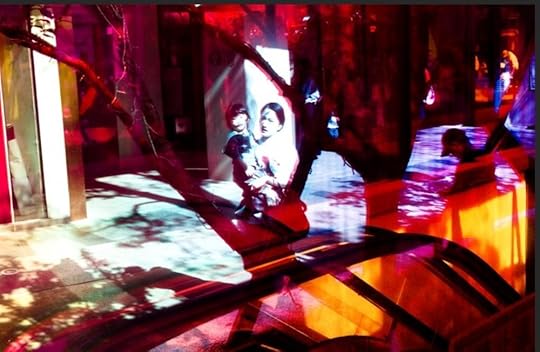
Reflection. Jhu Ziabin.
Generosity as Strategy.If strategy is future competitive advantage, generosity is smart for individual or company strategies.
Generosity builds good will which is both an asset and a moat.
It is an asset in that it can be tapped in the future.
It is a moat because when an individual or a company has been generous in times of trouble their employee or customer are less likely to switch to a different firm for a lower price or higher pay.
Generosity is also a key differentiator in that usually when a person or firm needs help there are few people willing to help someone out of power or in trouble. Those individuals and brands who do help stand out and their showing up and helping when others are not burns into the emotional and mental memory of the recipient.
Emotional connections are harder to sever or replace than financial connections.
A story shared with me:
“Long ago, must be 30 years ago or more, I went into Tiffany’s to purchase one cufflink.
The night before I had attended a black-tie event and one cufflink must have worked itself free (it was the solid type, and was difficult to get on and off), and I lost it off my sleeve. Just wasn't there when I got home.
I said to the counter person that I just wanted to buy one cufflink to match the other one.
She left.
She returned with the typical Tiffany's blue box with the white ribbon. "Here you go...no charge," she said.
I couldn't believe it.
You must be -- at least -- the 400th person I have told this story to.”
Brands today cannot succeed unless their employees are happy. It is the employees who after all provide the service to customers and clients. It is the employees who generate the ideas and solve the problems. It is often the employees who are most believed and can be the greatest ambassadors and advocates of a brand. Often employees are far more authentic ambassadors than a celebrity that companies give tens of millions too. Why not be generous in care, money, and attention to employees?

Paper-cut Silhouette. Xinfeng Hu.
Kindness is Key.One of the keys to a good life and possibly success at work is kindness.
This includes not just being kind to other people but kind to oneself.
Often we spend our time regretting, self-flagellating, doubting our decisions and wondering if we can ever measure up especially in a world filled with standards and measures that are unattainable.
In today’s competitive marketplace of rapidly transforming landscapes and constant benchmarking we often forget that we are dealing not just with buyers, sellers, users, members, competitors, analysts, scientists, management and employees but with analog, carbon based, feeling filled people.
Humans.
Messy and Moody. Dream filled and desire driven.. Anxiously ambitious. Undulating with uncertainty.
Kindness is a way to connect in a world where connections are key.
But it not easy to model in an Excel spreadsheet, display in a PowerPoint , or be described with any depth by GPT.
The machine will rapidly compute an answer, garland it with perspective, refine and correlate what has been fed into its innards, and then emit an output in a dazzling display of verbosity.
Answers that may awe us.
But rarely move us.
The author George Saunders gave a short and remarkable speech on the importance of kindness which everyone should listen to.
A key theme is “to err in the direction of kindness”
Some key passages of his talk to students
“When young, we’re anxious — understandably — to find out if we’ve got what it takes. Can we succeed? Can we build a viable life for ourselves? But you — in particular you, of this generation — may have noticed a certain cyclical quality to ambition. You do well in high-school, in hopes of getting into a good college, so you can do well in the good college, in the hopes of getting a good job, so you can do well in the good job so you can . . .
And this is actually O.K. If we’re going to become kinder, that process has to include taking ourselves seriously — as doers, as accomplishers, as dreamers. We have to do that, to be our best selves.
Still, accomplishment is unreliable. “Succeeding,” whatever that might mean to you, is hard, and the need to do so constantly renews itself (success is like a mountain that keeps growing ahead of you as you hike it), and there’s the very real danger that “succeeding” will take up your whole life, while the big questions go untended.
Do all the other things, the ambitious things — travel, get rich, get famous, innovate, lead, fall in love, make and lose fortunes, swim naked in wild jungle rivers (after first having it tested for monkey poop) – but as you do, to the extent that you can, err in the direction of kindness.”
Later George was interviewed on this talk which went viral after it was posted in the New York Times on why kindness was important and here is what he said:
“Ninety-nine percent of the time if you just do your best to be kind, you’re better off. It’s the basic things, like trying to have good manners, keeping your assumptions about the other person a little open, being willing to revise your opinion.
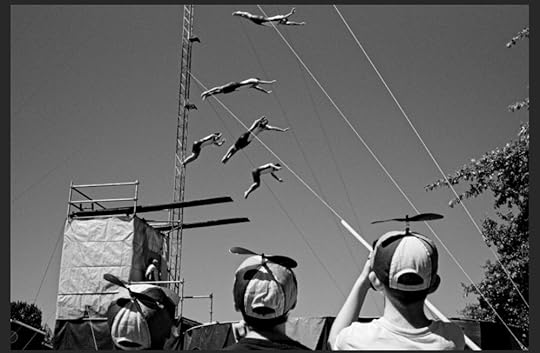
NW Washington State Fair. Ryder Collins.
Dignity Matters.Dignity is the right of a person to be valued and respected for their own sake, and to be treated ethically. It is of significance in morality , ethics , law and politics as an extension of the Enlightenment -era concepts of inherent, inalienable rights . The term may also be used to describe personal conduct, as in "behaving with dignity" (Wikipedia)
Marcel Proust wrote that it is “not to visit strange lands, but to possess other eyes that is the only true voyage”.
In Dignity: Seeking Respect in Back Row America, a book combining essay and photographs, Chris Arande reminds Front Row America “that we have removed ourselves physically and in spirit from much of the country and when we look back, we do it through papers and books filled with data.”
He goes on to note that “we have implemented policies that focus narrowly on one value of meaning which is the material. We emphasize GDP and efficiency, those things that we can measure, leaving behind those that are harder to quantify-like community, happiness, friendship, pride, and integration.
And if economics and material goods are the primary form of valuation then education is the way out implying that those who do not make it are dumb, lazy, and stupid.” And education is harder to get , more expensive and the elite schools a luxury good that resemble “Hermes” bags.
He warns that “this has ensured that all those at the bottom, educationally and economically-black, white, gay, straight, men and women feel excluded, rejected and most of all humiliated”
We have denied many their dignity, leaving a vacuum easily filled by drugs, anger, and resentment.
Try generosity, kindness and dignity.
It is not easy.
But it may be the way to being better.
March 31, 2024
Squeezing Time.

The Persistence of Memory by Salvador Dali.
This post was inspired by a conversation with and informed by content provided by Chris Outram, EVP, Head of Blockchain for Publicis Groupe Media ,who provides ongoing coaching and homework to keep me updated on Web 3 which Publicis defines as a constellation of AI, Blockchain, and XR (AR/VR/Spatial Compute).
1. Squeezing more into time.Is time squeezing us or are we squeezing time?
Everything seems and feels faster and paying attention or slowing down makes us a) wonder whether we will fall behind, b) fear we are missing out (FOMO), or c) we find things too slow, non-stimulative and boring.
We want it faster. Sooner. Quicker. More. Multi!
Across many fields we find ourselves addicted to an increased metronome of living:
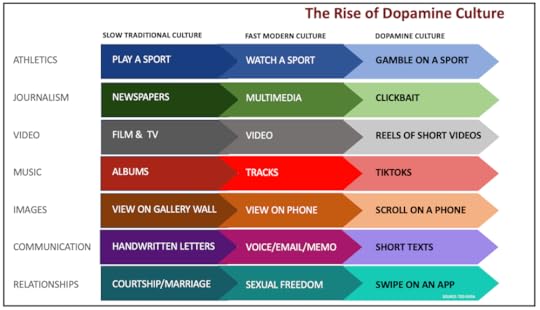
The Rise of Dopamine Culture by Ted Gioia
2. Squeezing Screens into the same Time.For the past few weeks I have been using Apple’s Vision Pro which in addition to being the best video and image content consumption device ever invented ( yes it is very expensive too) which also has pulled off a break-through in human and computer interface.
It has also enabled a multi-screen sensory experience where one can be writing a presentation, scrolling a social feed, watching a stock ticker, enjoying a movie and much more without the need for multiple screens or a lot of space.
It takes multi-tasking to another level and it can be done anywhere!
As the technology improves, the weight is diminished and the price reduced one can imagine that in less than three years this may be a large part of our future.
 3. Squeezed by being born at the wrong time.
3. Squeezed by being born at the wrong time.In the first chapter of my forthcoming book “Rethinking Work” I reveal many generational shifts and demographic trends that will alter the future of work. It was in this context that I learned about “Financial Nihilism” as Gen-Z and Millennials have a starkly different outlook to capitalism, companies and the way world works .
Many of them believing that the odds are stacked against them.
From Financial Nihilism by Travis Kling
“Demetri Kofinas, the host of the Hidden Forces podcast coined the term “financial nihilism” – the idea that cost of living is strangling most Americans; that upward mobility opportunity is out of reach for increasingly more people; that the American Dream is mostly a thing of the past; and that median home prices divided by median income is at a completely untenable level.
Financial Nihilism goes hand in hand with Populism – a political approach that strives to appeal to ordinary people who feel that their concerns are disregarded by established elite groups.”
Here is a chart that shows how difficult it is to buy a home:

Source: longtermtrends.net . As of October 2023.
4. Squeezing returns in a faster time frame through massive risk.“You can see Boomers (and GenX) bought all the houses at about 4.5x annual income. Then subprime lending fueled the housing bubble and the bubble collapsed. Not long thereafter, Millennials entered the workforce and got to the point where they could start buying houses at ~5.5x annual income. Then Covid happened, the Fed printed $6 trillion, and now houses are 7.5x annual income, much higher than even the peak of the housing bubble. Simply out of reach for many millions of Americans under 40. The numbers just don’t add up.”
While the equity markets have done well over time they are very expensive when compared to median income.
Below is the ratio of Median Household Income to the S&P 500. It calculates how many shares of the SPX index fund can one buy with a year’s worth of median income.
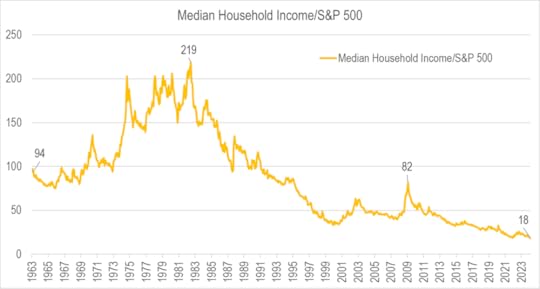
Source: FRED. As of Q3-23.
Back in the early 60’s you could get 94 shares of the SPX with the median household income. That peaked in the crash of 1982 at 219 shares and then structurally collapsed. The stock market is getting less and less affordable for the average American.
So what does one do?
Gamble and find ways to get massive returns in short time since the other options appear to be too slow, too expensive or too closed.
On sports. On meme stocks. On One Day Expiry Options.
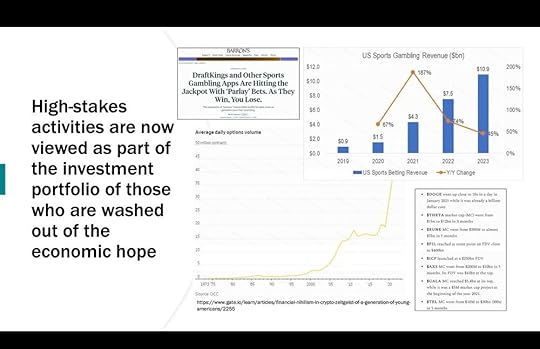
Or how about meme coins like catwifhat
People who bought 1 million catwifhat meme coins on Feb 24 would pay a little less than 17 cents which if they had sold a week later on March 1 would have got $5.69 or a 33X (3300) percent return.
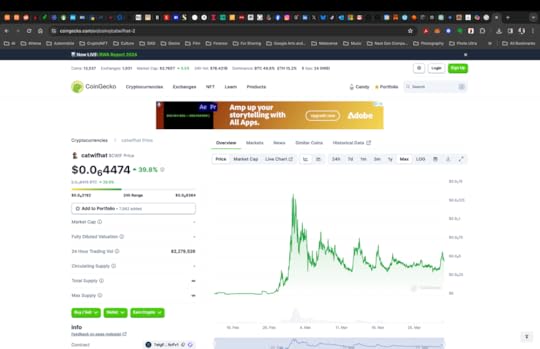
3300 percent in a week is mind blowing but is it really?
Lets look at recent price action on some of these coins below.
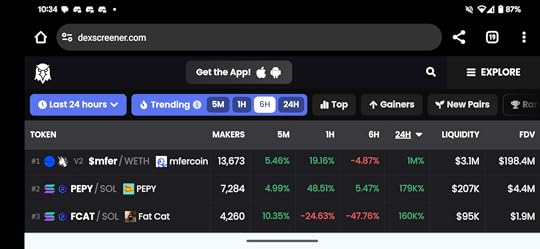
Yes, Mfer coin has gone up 1 million percent in the past 24 hours, 19.16 percent in the past hour and up 5.46 percent in the past five minutes. But if you had bought Fat Cat 6 hours ago you would be down 47.76 percent but if you had bought it five minutes ago you would be up 10.35 percent.
Hard to get excited about 10 percent return in a quarter for S&P 500 right?
Even though this stuff below will wipe most people out!
5. Short squeezing time?This meme stuff is irrational one might say.
So lets look at the financials of a stock that is valued at 9 billion dollars and began trading this week.
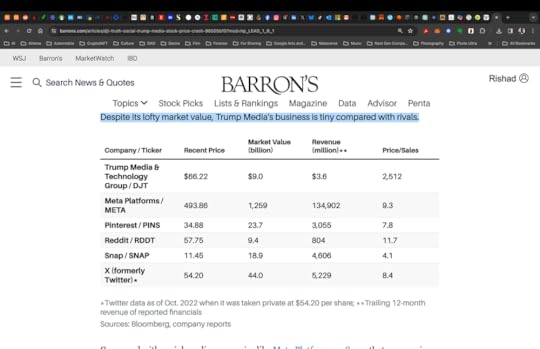
Yes, you are reading this chart correctly. DJT stock is valued at 9 billion dollars and has revenue of 3.6 million dollars in nine months with a loss of 50 million.
It is selling for 2512 times its revenue compared to Meta at 9.3 times revenue and Reddit which at 11.7 times revenue.
One has an urge to short it.
But one could end up with nothing but ones shorts since shorting this will be taking on a movement and not a financial instrument.
We are not just living in “interesting times”.
We are squeezing time…



